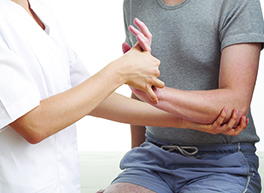
Unjamming a Jammed Finger
Many people have dislocated a finger at some point in their lives.
While these minor injuries often occur while playing sports such as basketball, they can also be the result of falling onto an outstretched hand or catching your finger between two objects.
Whether you’re an athlete or just going about your daily routine, it’s important to know how to handle a dislocated or jammed finger to promote proper healing and avoid long-term problems.
Recognize the Symptoms of Finger Injuries
Jammed fingers can be extremely painful and require immediate treatment to aid healing.
Here are some symptoms to watch out for:
- Sharp Pain: A jammed or dislocated finger often causes intense, immediate pain.
- Limited Mobility: You may find it hard or impossible to straighten or bend the finger.
- Visible Changes: The finger may look crooked or swollen.
- Altered Sensation or Color: Numbness, tingling, or a pale appearance could indicate more severe damage that needs urgent attention.
Immediate Steps to Take
Acting quickly can make a big difference in your recovery.
According to the Hospital for Special Surgery in New York, if the finger is broken, a lack of treatment can lead to arthritis or other debilitating conditions.
Follow these steps to care for your finger.
1) Remove Rings or Jewelry
Remove any rings or jewelry from your hand immediately.
Swelling can make it difficult to remove them later and might even cause further injury or restrict blood flow.
2) Ice and Elevate
Apply ice for 15 minutes, wait until the finger temperature returns to normal and repeat the process.
3) Check the Injury
After the swelling goes down and the pain diminishes, try to move the finger very slightly. If the injury is mild, you will be able to move it with little discomfort after a short time.
However, if your finger has a break in the skin, feels cold or numb, or looks pale, seek medical attention right away.
When to See a Doctor
Certain symptoms mean you need medical help right away:
- Open Wounds or Cuts: These could lead to infection if not treated properly.
- Cold, Numb, or Pale Finger: These signs suggest a lack of blood flow or nerve damage.
- Severe Pain or Immobility: This could indicate a fracture or severe dislocation.
A doctor will likely take an X-ray to assess the injury.
After taking an x-ray of your finger, your physician may prescribe a splint to minimize motion or may “buddy tape” your injured finger to an adjacent finger to keep it straight and protected as the tendon or bone heals.
Recovery and Rehabilitation: Your Path to Healing
During the healing process and with your physician’s advice, your physical therapist will recommend a series of strengthening exercises to ensure that your finger mends quickly and properly.
Our specialists at The Jackson Clinics will guide you through exercises designed to restore function and prevent future injury.
Exercises to Strengthen and Heal Your Finger
During recovery, you will focus on exercises that help your finger heal properly:
- Assisted Finger Stretches: Use your other hand to gently stretch the injured finger to improve flexibility.
- Finger Bends: Slowly bend the injured finger to its comfortable limit and then straighten it again to restore movement.
- Resistance Exercises: Perform exercises using a rubber band to gradually rebuild strength in the finger.
This exercise regimen will focus on protecting the injured finger, strengthening it and maximizing your range of motion so that your hand can get back to normal functioning as soon as possible.
Did you know you have Direct Access* to Physical Therapy? No referral, no problem!
Jammed Finger Healing Time
Wondering about your jammed finger healing time?
It all depends on the severity of the injury.
- For a mild jammed finger, healing can take anywhere from a few days to a couple of weeks. During this time, the pain and swelling should gradually decrease, and you’ll start regaining mobility.
- However, if the finger is more severely injured, like with a dislocation or fracture, the healing process can take several weeks or even months.
To speed up your jammed finger healing time, make sure you follow the right steps: ice and elevate the finger, rest it as much as possible, and do gentle exercises as recommended by your healthcare provider.
Prevent Long-Term Complications
To avoid permanent damage, don’t ignore a jammed or dislocated finger.
Start treatment right away and follow through with a rehabilitation plan.
Take Action Now
Make sure a jammed finger doesn’t leave you with a permanent injury.
After seeing your physician, visit us. We can help you get your finger out of whatever jam it got into.
The Jackson Clinics serves 18 locations throughout Northern Virginia.
Find one near you: https://thejacksonclinics.com/locations/
















